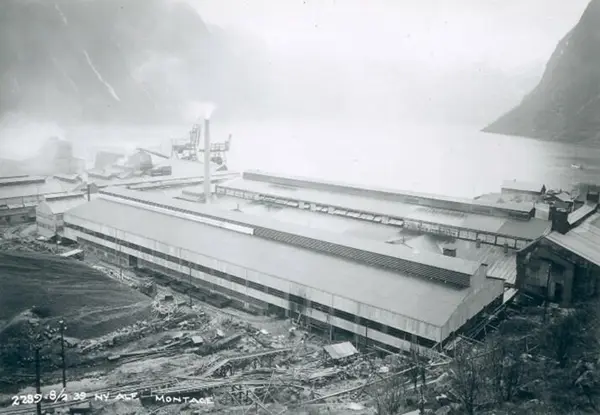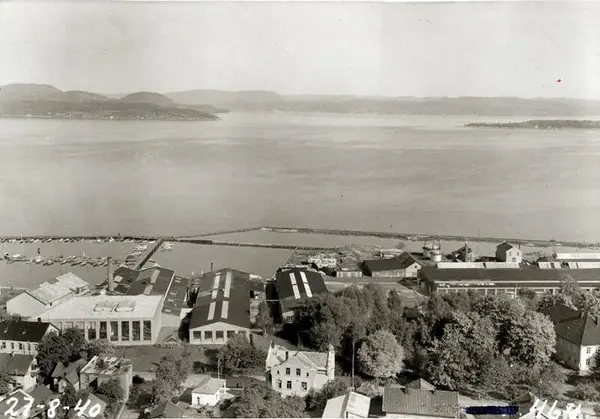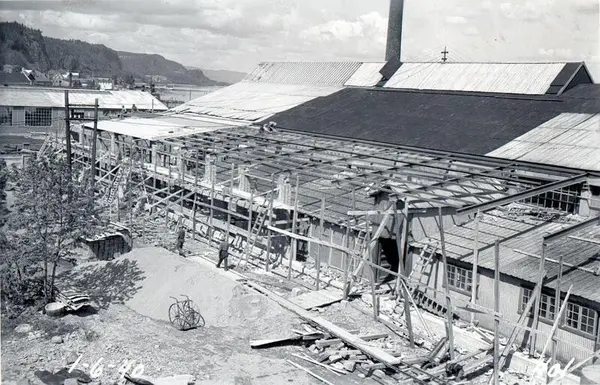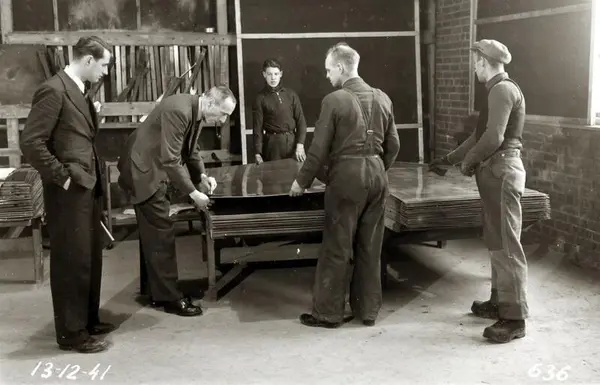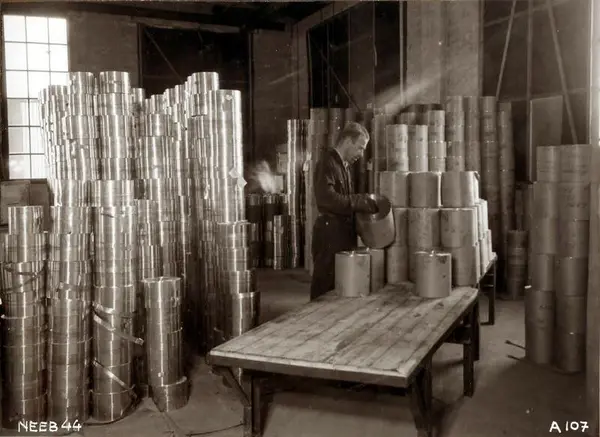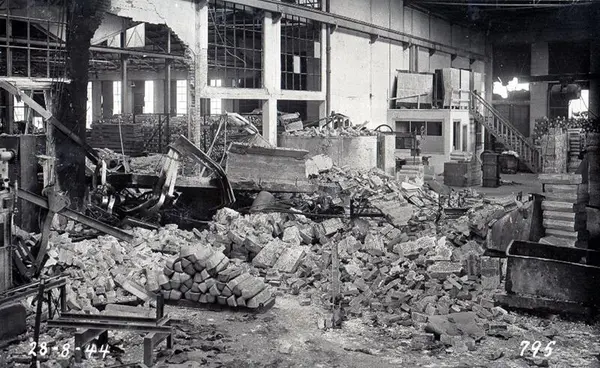Resistance and cooperation
When World War II came to Norway in 1940, A/S Norsk (Norwegian) Aluminum Company (Naco) in Høyanger and the subsidiary A/S Nordisk (Nordic) Aluminum Industry (Nordisk) in Holmestrand were in progress.
The company had a good economy and was among the country's most technologically advanced companies.
- 1/2
The factory in Hoyanger in 1939. - 2/2
The factory in Holmestrand in 1940.
Development after the German occupation
The German occupation did not prevent further development for the company. On the contrary, the occupying power had big plans for the aluminum industry in Norway. The goal was that Norway, with its hydropower resources, would supply the Great German Empire with aluminum. The plan was to increase Norwegian aluminum production from 37,000 tonnes to staggering 240,000 tonnes by 1944. Two new companies were created to realize the gigantic development plans. These were the German Nordag and Nordisk Lettmetall AS in Porsgrunn, where Norsk Hydro was one of the owners. Hydro had long wanted to enter the aluminum industry, and the company had the best conditions in terms of hydropower resources and capital.
Naco, the country's largest aluminum company, had long tried to prevent Hydro from getting involved in aluminum. The company had through its Canadian principal owner, Alcan, gained monopoly on the Scandinavian market and did not want competition. The Germans' commitment to the Norwegian aluminum industry, together with Hydro's entry into the business, helped Naco with Sigurd Kloumann at the forefront to assist with expertise to ensure continued operations. An extensive collaboration project between Naco and the occupying power was established. Large construction work was started in Årdal, Sunndalsøra, Glomfjord, Odda and Herøya. If the development plans succeeded, Norway would become one of the world's largest aluminum producers and contribute to German victory.
- 1/1
The expansion of the rolling mill in 1940.
In the short term, however, materials for aircraft in duraluminum were the most important for German warfare. Duraluminum contains small amounts of manganese, copper and magnesium and is a sturdy material. The year before the war came to Norway, Nordisk produced this metal for Norwegian fighter aircraft production. The fact that Nordic was capable of this type of production made the company one of the first to be put under German administration in 1940. The cooperation with the occupying power meant that the production of both duraluminum and aluminum strips for the canning industry at Nordisk was strengthened. The metal went to German fighter jets and supplies at the front, and the company gained experience and expertise that became of great importance after the war.
Production to German specifications was challenging and technically demanding. Therefore, it was time-consuming for the factory to meet the German requirements in terms of both quality and quantity. The rolling mill was expanded to increase production capacity, and with technical assistance from German Dürener Metall Werke (who was a developer and patent holder of duraluminum), Nordisk eventually met the requirements of production for the German aviation industry.
- 1/1
Inspection of dural plates in 1941.
At the same time, demand for aluminum canned materials increased. Canned food was not only in demand as a supply at the front, but also because of a lack of food and sheet metal. Nordic pressed ready-made boxes, but primarily focused on delivering intermediate products to the canning industry.
Consequently, the production capacity of canning was expanded in 1942, and to the canned manufacturers, Nordisk provided expertise and financial assistance to enable them to drop-forge the boxes on their own.
- 1/1
The production effort strengthened Nordisk as an intermediate product manufacturer, and eventually also resulted in successful duraluminum production for military aircraft. In 1944, Nordisk produced twice the German demand for the supply of duraluminum. That made Holmestrand exposed for precision bombing.
To prevent a bomb attack, Nordic was subjected to sabotage on the night of August 27, 1944. The transformer that supplied the rolling mill with electricity was annihilated and thus put an end to production. The communist sabotage organization Saborg was behind it.
In addition, the staff delayed the production, which contributed to a complete stop in the deliveries to the German war industry in the final phase of the war.
- 1/1
Destroyed transformer after the sabotage in 1944.
After all, Norway was not the country to deliver Hitler metal so that he could win the war. Nordisk Lettmetall was bombed by the Allies on July 24, 1943, and the occupying power's plans for the Norwegian aluminum industry were not realized. This was not due to the leaders of central Norwegian companies, but rather to the lack of bauxite raw material as the war in Europe intensified. The new facilities in Norway built by the occupying power never managed to produce as much as one gram of light metal.
In Holmestrand, on the other hand, Nordisk as a manufacturer of intermediate products was further strengthened. The occupation led to investments in increased capacity and transfer of knowledge, patents and technology from the most advanced technology environments in the world. Despite the sabotage, the company was well equipped when peace was a fact and new markets opened up.
After the war, corporate management's cooperation with the occupying power was subject to criticism, but did not lead to any punishment. An important argument in the case was the Administration's policy of keeping the wheels turning for the Norwegian industry, which was also the view of the London Government. At the entrance to the Aluminum Museum stands the bust of Sigurd Kloumann as a memory of one of Norway's largest industrial builders. A man who made metal his life's work – but who was also considered by many just after the war a traitor and therefore has fallen into the shadows.
